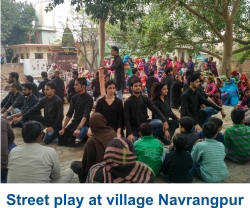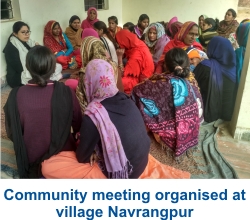Promoting Women Empowerment in Rural India
The Indian constitution guarantees equality of women (Article 14), equality of opportunity (Article 16) and equal pay for equal work (Article 39(d))1. Jawaharlal Nehru had said “You can tell the condition of the nation by looking at the status of women.” India ranks 113 out of 135 on the World Economic Forum’s Gender Gap Index. As 1 in 7 girls marries before the age of 18 in developing countries (UNFPA 2012),2 early and forced marriages remain a key issue in India as well and an important factor limiting young women’s engagement in both education and economic activities. The rural female population in India is almost 360 million but only 31% of them are working. Because of lack of acceptance from the male dominant society, women suffer immensely. Empowerment of women should thus be a key aspect in all social development programmes. This helps to make them economically, socially and politically independent.
Unnati (Aao Sanwarein Apna Kal), an initiative by Development Alternatives
(DA) with support from Honda Motorcycle and Scooter Pvt. Ltd is a three-year
programme which aims to transform girls’ lives as self-reliant individuals.
The programme supports girls who aspire to achieve something inspirational
in their life, but due to lack of resources and family support they are
unable to move forward. The project aims to provide vocational training to
250 girls between the age group of 17-21 and promote entrepreneurship
amongst young girls. 25 school girls will be supported for higher education
and 40 school girls will be trained as WASH Ambassadors in four villages of
Manesar near Delhi.
The project is implemented based on DA’s well tested 3 A’s approach i.e, Assessment, Awareness and Action. Assessment helps to understand the local context and get a real picture and thus act as a foundation for the entire project plan. The next step is Awareness, wherein the people of the community are made aware of the concerns and the possible solutions for the same. Currently, we are at this stage of the programme and here comes the role of communication based on which DA builds the acceptance and its root in any community.
Since this is a rural community, focus is on using communication tools which
are entertaining and at the same time engaging. Tools such as interactive
sessions, community meetings, rallies, street plays, wall paintings etc. are
being used to engage with people. Various IEC materials are also being used
for awareness creation such as banners, posters, pamphlets etc.

Street plays have been organised in the four villages of Manesar, namely – Shikohpur, Navrangpur, Nakhdaula and Pathredi. The plays focused on creating awareness among the community members on the importance of the girl child, education of girls and female foeticide which were followed by group discussions. Through the plays, over 1500 community members have been reached so far. The result of the street play was that, in the village, Pathredi, 10 girls were born in the same month and the entire village celebrated the birth of all the girl children.
Community meetings have been organised in all the four villages to understand the knowledge and local perspective of people towards gender equality, adolescence, atrocities of women etc. Nearly 50 – 60 people attended these community meetings monthly. Rallies have also been organised in participation of school children to create awareness in the community about health and sanitation.
This project has initiated a unique way of addressing the issue of gender equality and women’s empowerment by promoting actions that are led by those who are the ultimate change makers. The ultimate success of this initiative will, however, lie in its ability to transform the perspective of community towards women and ultimately the women, who will be empowered to take charge of their lives themselves. ■
Jyoti Shresth
jshresth@devalt.org
Endnotes
1 https://www.slideshare.net/Shashi04/women-empowerment-ict
2 http://www3.weforum.org/docs/GGGR14/GGGR_
CompleteReport_2014.pdf